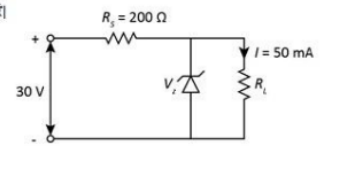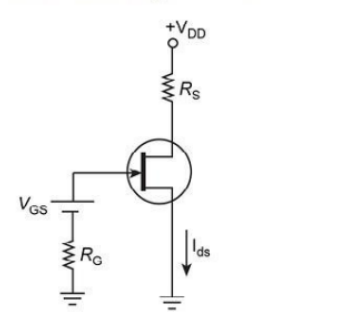Hi students, Welcome to Amans Maths Blogs (AMBIPi). Are you preparing for SSC Scientific Assistant and looking for SSC Scientific Assistant Electronics Questions 201 to 220 with Answer Keys? In this article, you will get previous year questions of SSC Scientific Assistant IMD (Indian Meteorological Department), which helps you in the preparation of government job of SSC IMD Scientific assistant.
SSC Scientific Assistant IMD Previous Year Questions
SSC Scientific Assistant Electronic Question No: 201
Consider the following the semi-conductor diodes.
(i) Germanium diode
(ii) Silicon diode
(iii) Schottky diode
(iv) Tunnel diode The correct sequence of forward voltage drop in the decreasing order is:
Option A : 1 , 3 , 2 , 4
Option B : 1 , 2 , 3 ,4
Option C : 3 , 4 , 2 , 1
Option D : 2 , 3 , 1 , 4
Show/Hide Answer Key
Option D : 2 , 3 , 1 , 4
SSC Scientific Assistant Electronic Question No: 202
The zener diode in the circuit has a zener breakdown voltage of 5 Volt . Calculate the power dissipation in the resistance Rs.

Option A : 0.5 W
Option B : 1 W
Option C : 3.125 W
Option D : 3 W
Show/Hide Answer Key
Option C : 3.125 W
SSC Scientific Assistant Electronic Question No: 203
A diode when connected in series with the output , then the circuit is called ______.
Option A : Limiter
Option B : Series clipper
Option C : Parallel clipper
Option D : IC voltage regulator
Show/Hide Answer Key
Option B : Series clipper
SSC Scientific Assistant Electronic Question No: 204
A device is referred to as a linear device when the graph between the current and voltage across the device is a ______
Option A : Exponential
Option B : Non-exponential
Option C : Straight line
Option D : Constant
Show/Hide Answer Key
Option C : Straight line
SSC Scientific Assistant Electronic Question Paper No: 205
Calculate the hall voltage when the magnetic field is 8 A/m, current is 4, which is 5 m and the concentration of carrier is 100000.
Option A : 4.125 V
Option B : 0.3125 V
Option C : 4.2 V
Option D : 0.4 V
Show/Hide Answer Key
Option C : 0.4 V
SSC Scientific Assistant Electronic Question No: 206
Using which diode in a regulator power supply, the unregulated input voltage as compared to the regulated output voltage will be larger ?
Option A : Photo diode
Option B : p-n junction diode
Option C : Zener diode
Option D : Gunn diode
Show/Hide Answer Key
Option C : Zener diode
SSC Scientific Assistant Electronic Question No: 207
Which region covers the highest area in the transistor ?
Option A : Emitter
Option B : Collector
Option C : Base
Option D : Base emitter
Show/Hide Answer Key
Option B : Collector
SSC Scientific Assistant Electronic Question Paper No: 208
What is the region of operation of bipolar junction transistor (BJT) where both the junctions are in the forward biased?
Option A : Active region
Option B : Ohmic region
Option C : Saturation region
Option D : Cut-off
Show/Hide Answer Key
Option C : Saturation region
SSC Scientific Assistant Electronic Question Paper No: 209
Which among the following the are the disadvantages of FET over BJT:
(i) It has high input resistance
(ii) It has large bandwidth
(iii) It has more noise
(iv) It only allows the flow of majority charge carrier
Option A : 1 and 3
Option B : 2 and 4
Option C : 3 and 2
Option D : 4 only
Show/Hide Answer Key
Option D : 4 only
Previous Year Question SSC Scientific Assistant Electronic : 210
Which circuit takes the less chip area in the large scale integration ?
Option A : TTL logic circuits
Option B : Bipolar circuits
Option C : High power circuits
Option D : CMOS circuits
Show/Hide Answer Key
Option D : CMOS circuits
SSC Scientific Assistant Electronic Question No: 211
The JFET in the circuit shown in figure has an IDSS = 20 mA and Vp = 5 P . The value of the resistance R3 for a drain current Ids = 12.8 mA is ______
Option A : 15.00 Ω
Option B : 47.23 Ω
Option C : 1k Ω
Option D : 78.12 Ω
Show/Hide Answer Key
Option D : 78.12 Ω
SSC Scientific Assistant Electronic Question No: 212
Consider the following
(i) MOSFET can be used as a voltage controlled capacitor
(ii) MOSFET can be used both as a voltage and a current controlled inductor.
Option A : (i) is True but (ii) is False
Option B : (ii) is True but (i) is False
Option C : Only (i) is True
Option D : Both (i) and (ii) are True
Show/Hide Answer Key
Option C : Only (i) is True
SSC Scientific Assistant Electronic Question No: 213
The voltage gain of an amplifier without feedback and a negative feedback are 140 and 30 respectively. The percentage of negative feedback (beta ) is :
Option A : 3%
Option B : 4%
Option C : 5%
Option D : 2%
Show/Hide Answer Key
Option A : 3%
SSC Scientific Assistant Electronic Question No: 214
What are the properties of a power amplifier that are to be considered while designing a good power amplifier circuit ?
Option A : Distortion , gain and bias stabilization
Option B : Frequency response
Option C : Sensitivity
Option D : All options are correct
Show/Hide Answer Key
Option A : Distortion , gain , and bias stabilization
SSC Scientific Assistant Electronic Question Paper No: 215
A tuned amplifier has a peak output of 9 MHz and quality factor of 90. What is the bandwidth of a tuned amplifier ?
Option A : 100 MHz
Option B : 100 kHz
Option C : 5.4 MHz
Option D : 6.05 MHz
Show/Hide Answer Key
Option B : 100 kHz
SSC Scientific Assistant Electronic Question No: 216
A common emitter transistor amplifier has a collector load of 40 k- Ω , voltage gain is 400 and input resistance is 2-kΩ. Calculate the value of voltage amplification of the amplifier.
Option A : 500
Option B : 2000
Option C : 8000
Option D : 7500
Show/Hide Answer Key
Option C : 8000
SSC Scientific Assistant Electronic Question No: 217
Determine the number of different node of pair voltages for a network with 9 nodes and 18 branches.
Option A : 7
Option B : 10
Option C : 45
Option D : 36
Show/Hide Answer Key
Option D : 36
SSC Scientific Assistant Electronic Question Paper No: 218
Which among the following theorems can be applied to any active or passive network ?
Option A : Thevenin’s theorem
Option B : Tellegen theorem
Option C : Superposition theorem
Option D : Norton theorem
Show/Hide Answer Key
Option B : Tellegen theorem
SSC Scientific Assistant Electronic Question Paper No: 219
The Norton equivalent between A and B for the circuit is
Option A : 2 A and 2 ohms
Option B : 3.5 A and 1 ohms
Option C : 0.41 A and 4.4 ohms
Option D : 1 A and 2 ohms
Show/Hide Answer Key
Option C : 0.41 A and 4.4 ohms
SSC Scientific Assistant Electronic Question : 220
An RLC resonant circuit has a resonance frequency of 2.5 mHz and a bandwidth of 20 kHz . If capacitance is 120 pF , then effective resistance (in ohms ) of the circuit will be
Option A : 29.5
Option B : 4.7
Option C : 14.75
Option D : 2.66
Show/Hide Answer Key
Option D : 2.66
Know About SSC Scientific Assistant: Click Here.
Get SSC Scientific Assistant Previous Year Questions.
| SSC Scientific Assistant Previous Year Questions Bank |
| SSC General Intelligence Previous Year Questions | 1 to 20 | 21 to 40 | 41 to 60 | 61 to 75 |
| SSC General Awareness Previous Year Questions | 1 to 20 | 21 to 40 | 41 to 60 | 61 to 75 |
| SSC Computer Science Previous Year Questions | 1 to 20 | 21 to 40 | 41 to 60 | 61 to 80 | 81 to 100 | 101 to 120 | 121 to 140 | 141 to 160| 161 to 180 | 181 to 200 |
| SSC Quantitative Aptitude Previous Year Questions | 1 to 20 | 21 to 40 | 41 to 60 | 61 to 75 |
| SSC Physics Previous Year Questions | 1 to 20 | 21 to 40 | 41 to 60 | 61 to 80 | 81 to 100 |
| SSC Electronics Previous Year Questions | 1 to 20 | 21 to 40 | 41 to 60 | 61 to 80 | 81 to 100 101 to 120 | 121 to 140 | 141 to 160 | 161 to 180 | 181 to 200 | 201 to 220 | 221 to 240 | 241 to 260 | 261 to 280 | 281 to 295 | |


